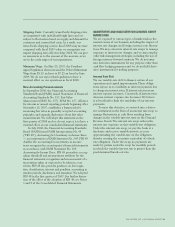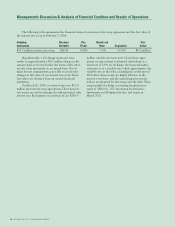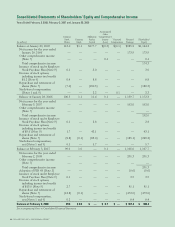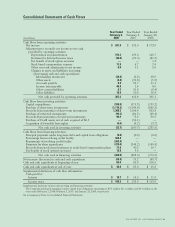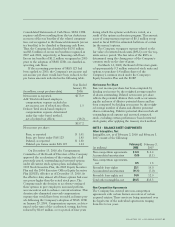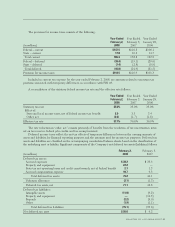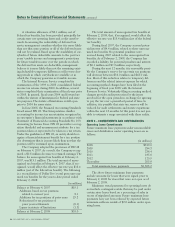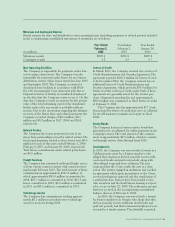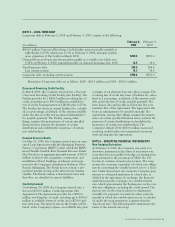Dollar Tree 2007 Annual Report Download - page 36
Download and view the complete annual report
Please find page 36 of the 2007 Dollar Tree annual report below. You can navigate through the pages in the report by either clicking on the pages listed below, or by using the keyword search tool below to find specific information within the annual report.
34
DOLLAR TREE, INC. • 2007 ANNUAL REPORT
Notes to Consolidated Financial Statements continued
133). This interest rate swap is recorded at fair value
in the accompanying consolidated balance sheets as a
component of “other liabilities” (see Note 6). Changes
in the fair value of this interest rate swap are recorded
as “interest expense” in the accompanying consolidated
statements of operations. The fair value of this interest
rate swap at February 2, 2008 was $0.5 million.
The fair value at February 3, 2007 was less than
$0.1 million.
Lease Accounting
The Company leases all of its retail locations under
operating leases. The Company recognizes minimum
rent expense starting when possession of the property
is taken from the landlord, which normally includes a
construction period prior to store opening. When a
lease contains a predetermined fixed escalation of the
minimum rent, the Company recognizes the related
rent expense on a straight-line basis and records the
difference between the recognized rental expense and
the amounts payable under the lease as deferred rent.
The Company also receives tenant allowances, which
are recorded in deferred rent and are amortized as a
reduction of rent expense over the term of the lease.
Revenue Recognition
The Company recognizes sales revenue at the time a
sale is made to its customer.
Taxes Collected
The Company reports taxes assessed by a governmen-
tal authority that are directly imposed on revenue-pro-
ducing transactions (i.e., sales tax) on a net (excluded
from revenues) basis.
Cost of Sales
The Company includes the cost of merchandise, ware-
housing and distribution costs, and certain occupancy
costs in cost of sales.
Pre-Opening Costs
The Company expenses pre-opening costs for new,
expanded and relocated stores, as incurred.
Advertising Costs
The Company expenses advertising costs as they are
incurred. Advertising costs approximated $8.4 million,
$10.6 million and $11.8 million for the years ended
February 2, 2008, February 3, 2007, and January 28,
2006, respectively.
Income Taxes
Income taxes are accounted for under the asset and
liability method. Deferred tax assets and liabilities are
recognized for the future tax consequences attributa-
ble to differences between financial statement carrying
amounts of existing assets and liabilities and their
respective tax bases. Deferred tax assets and liabilities
are measured using enacted tax rates expected to apply
to taxable income in the years in which those tempo-
rary differences are expected to be recovered or settled.
The effect on deferred tax assets and liabilities of a
change in tax rates is recognized in income in the peri-
od that includes the enactment date of such change.
On February 4, 2007, the Company adopted
Financial Accounting Standards Board Interpretation
No. 48, Accounting for Uncertainty in Income Taxes
(FIN 48), which clarified the accounting for uncertain-
ty in income taxes recognized in the financial state-
ments in accordance with SFAS No. 109, Accounting
for Income Taxes. With the adoption of FIN 48, the
Company includes interest and penalties in the provi-
sion for income tax expense and income taxes payable.
The Company does not provide for any penalties asso-
ciated with tax contingencies unless they are consid-
ered probable of assessment. Refer to Note 3 for
further discussion of income taxes and the impact of
adopting FIN 48.
Stock-Based Compensation
Effective, January 29, 2006, the Company adopted
Statement of Financial Accounting Standards, No. 123
(revised 2004), Share-Based Payment, (SFAS 123R).
This statement is a revision of SFAS 123 and super-
sedes Accounting Principle Board Opinion No. 25,
Accounting for Stock Issued to Employees, (APB Opinion
25). SFAS 123R requires all share-based payments to
employees, including grants of employee stock options,
to be recognized in the financial statements based on
their fair values. The Company adopted SFAS 123R
using the modified prospective method, which
requires application of the standard to all awards
granted, modified, repurchased or cancelled on or after
January 29, 2006, and to all awards granted to
employees that were unvested as of January 29, 2006.
In accordance with the modified prospective method
of implementation, 2005 financial statements have not
been restated to reflect the impact of SFAS 123R.
During 2006, the Company recognized $1.8 million of
stock-based compensation expense as a result of the
adoption of SFAS 123R. Total stock-based compensa-
tion expense for 2007, 2006 and 2005 was $11.3 mil-
lion, $6.7 million and $2.4 million, respectively.
Through January 28, 2006, the Company applied the
intrinsic value recognition and measurement principles
of APB Opinion 25 and related Interpretations in
accounting for its stock-based employee compensation
plans. Prior to the adoption of SFAS 123R, the
Company reported all tax benefits resulting from the
exercise of stock options as operating cash flows in the



